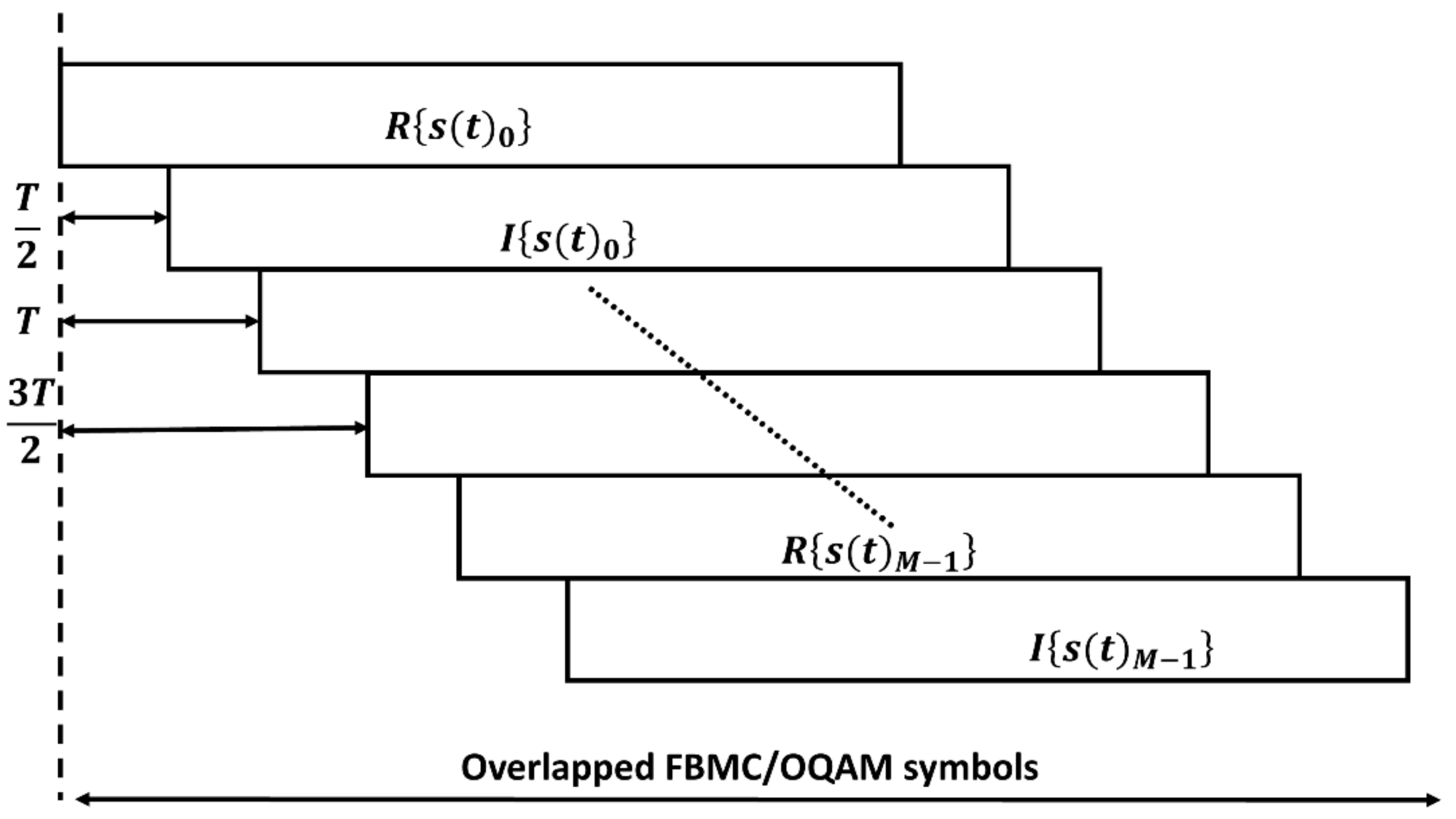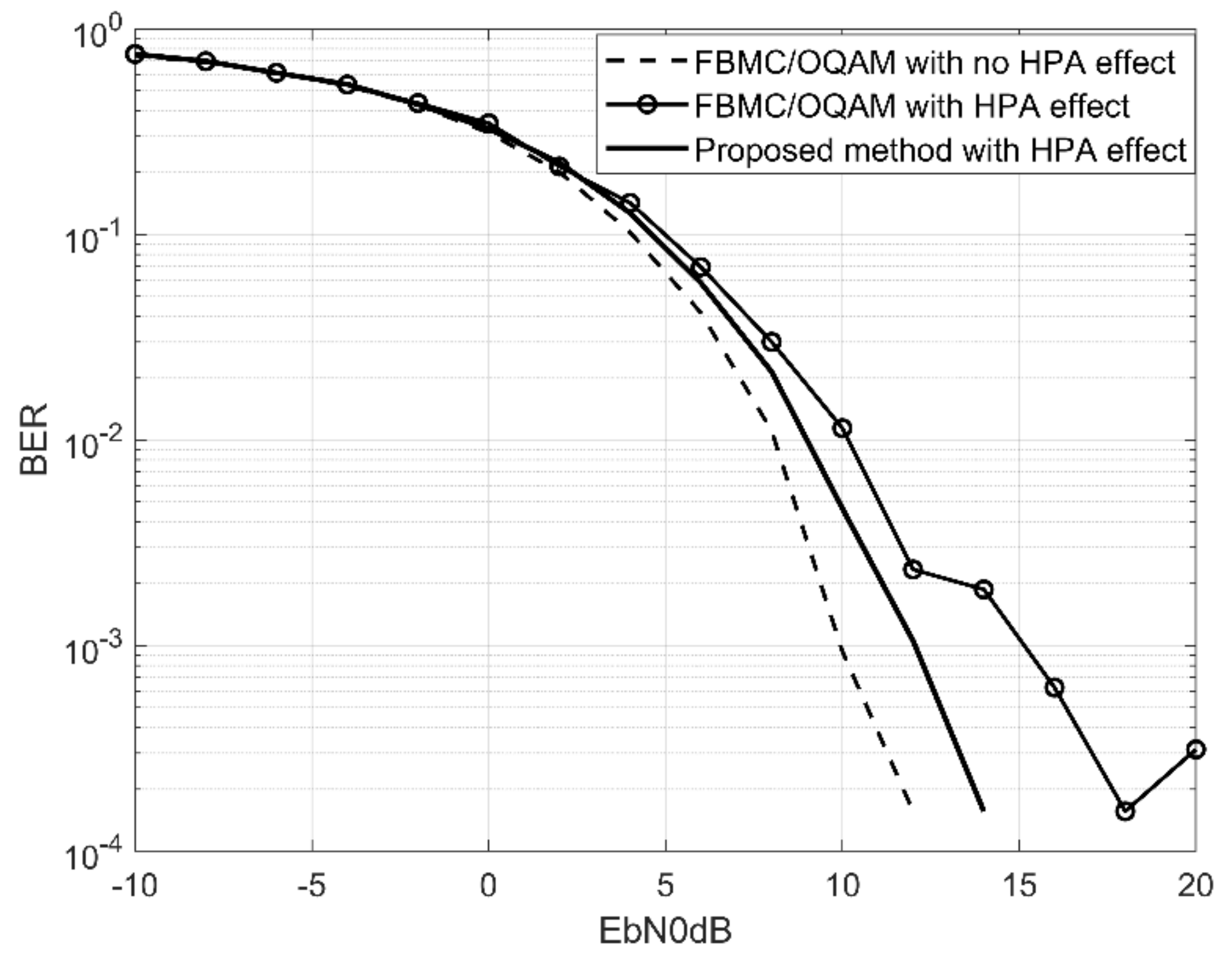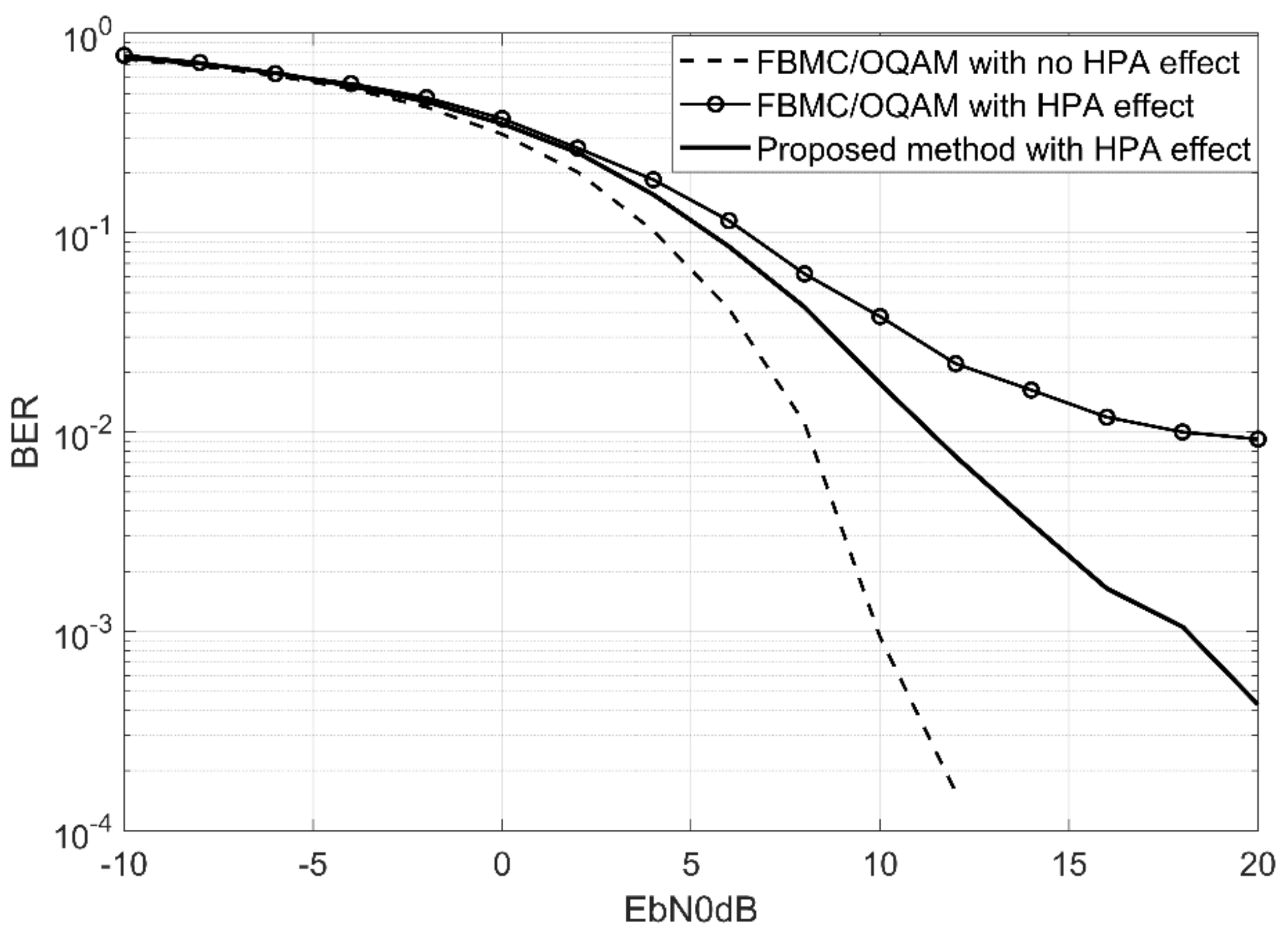Peak-to-Average Power Ratio Reduction Method Based on Partial Transmit Sequence and Discrete Fourier Transform Spreading
Abstract
1. Introduction
2. FBMC/OQAM Structure
3. Proposed Method
3.1. DFT Spreading
3.2. PTS
3.3. Combination of DFT Spreading and PTS
- In the simulations, we selected W = {−1,1} = 2 as a phase factor because a higher value than W = 2 complicates the calculations [9]; therefore, the total number of candidates is 2V.
- After creating the PTS sequences, the output is copied K times and filtered with the PPN filter.
- The PAPR of the filtered sequences is calculated, and the PAPR equations for each part are as follows:
- 4.
- The selection of the optimum phase factors is as follows:
- 5.
- After choosing the candidate with the least PAPR, the real and imaginary parts are combined after staggering the later by T/2.
4. Simulation Results
4.1. PAPR Performance
4.2. Computational Complexity
4.3. BER Performance
5. Conclusions
Author Contributions
Funding
Acknowledgments
Conflicts of Interest
References
- Farhang-Boroujeny, B. Filter bank multicarrier modulation: A waveform candidate for 5G and beyond. Adv. Electr. Eng. 2014, 1–25. [Google Scholar] [CrossRef]
- Banelli, P.; Buzzi, S.; Colavolpe, G.; Modenini, A.; Rusek, F.; Ugolini, A. Modulation Formats and Waveforms for 5G Networks: Who Will Be the Heir of OFDM? An overview of alternative modulation schemes for improved spectral efficiency. IEEE Signal Process. Mag. 2014, 31, 80–93. [Google Scholar] [CrossRef]
- Jiang, W.; Schellmann, M. Suppressing the out-of-band power radiation in multi-carrier systems: A comparative study. In Proceedings of the 2012 IEEE Global Communications Conference (GLOBECOM), Anaheim, CA, USA, 3–7 December 2012; pp. 1477–1482. [Google Scholar] [CrossRef]
- Han, S.H.; Lee, J.H. An overview of peak-to-average power ratio reduction techniques for multicarrier transmission. IEEE Wirel. Commun. 2005, 12, 56–65. [Google Scholar] [CrossRef]
- Lu, S.; Qu, D.; He, Y. Sliding Window Tone Reservation Technique for the Peak-to-Average Power Ratio Reduction of FBMC-OQAM Signals. IEEE Wirel. Commun. Lett. 2012, 1, 268–271. [Google Scholar] [CrossRef]
- Wang, H.; Wang, X.; Xu, L.; Du, W. Hybrid PAPR Reduction Scheme for FBMC/OQAM Systems Based on Multi Data Block PTS and TR Methods. IEEE Access 2016, 4, 4761–4768. [Google Scholar] [CrossRef]
- He, Z.; Zhou, L.; Chen, Y.; Ling, X. Low-Complexity PTS Scheme for PAPR Reduction in FBMC-OQAM Systems. IEEE Commun. Lett. 2018, 22, 2322–2325. [Google Scholar] [CrossRef]
- Hanprasitkum, A.; Numsomran, A.; Boonsrimuang, P.; Boonsrimuang, P. Improved PTS method with new weighting factor technique for FBMC-OQAM systems. In Proceedings of the 2017 19th International Conference on Advanced Communications Technology (ICACT), Bongpyeong, Korea, 19–22 February 2017. [Google Scholar] [CrossRef]
- Moon, J.; Nam, Y.; Kim, J. PAPR Reduction in the FBMC-OQAM System via Segment-Based Optimization. IEEE Access 2018, 6, 4994–5002. [Google Scholar] [CrossRef]
- Ren, S.; Deng, H.; Qian, X.; Liu, Y. Sparse PTS scheme based on TR schemes for PAPR reduction in FBMC-OQAM systems. IET Commun. 2018, 12, 1722–1727. [Google Scholar] [CrossRef]
- Qu, D.; Lu, S.; Jiang, T. Multi-Block Joint Optimization for the Peak-to-Average Power Ratio Reduction of FBMC-OQAM Signals. IEEE Trans. Signal Process. 2013, 1605–1613. [Google Scholar] [CrossRef]
- Na, D.; Choi, K. Low PAPR FBMC. IEEE Trans. Wirel. Commun. 2017, 17, 182–193. [Google Scholar] [CrossRef]
- Aboul-Dahab, M.A.; Foud, M.M.; Roshdy, R.A. Generalized Discrete Fourier Transformfor FBMC Peak to Average Power Ratio Reduction. IEEE Access 2019, 7, 81730–81740. [Google Scholar] [CrossRef]
- Nissel, R.; Rupp, M. Pruned DFT-Spread FBMC: Low PAPR, Low Latency, High Spectral Efficiency. IEEE Trans. Commun. 2018, 66, 4811–4825. [Google Scholar] [CrossRef]
- Yuen, C.H.; Amini, P.; Farhang-Boroujeny, B. Single carrier frequency division multiple access (SC-FDMA) for filter bank multicarrier communication systems. In Proceedings of the 5th IEEE International Conference on Cognitive Radio Oriented Wireless Networks and Communications (CROWNCOM), Cannes, France, 9–11 June 2010; pp. 1–5. [Google Scholar]
- Bellanger, M.D.; LeRuyet, D.; Roviras, D.; Terre, M.; Nossek, J.; Baltar, L.; Bai, Q.; Waldhauser, D.; Renfors, M.; Ihalainen, T.; et al. FBMC Physical Layer: A Primer; PHYDYAS, 2010; Available online: http://www.ict-phydyas.org/ (accessed on 5 March 2021).
- Fulai, Z.; Luokun, L.; Jinjin, Y. DFT-spread combined with PTS method to reduce the PAPR in VLC-OFDM system. In Proceedings of the 2014 IEEE 5th International Conference on Software Engineering and Services Science, Beijing, China, 27–29 June 2014; pp. 629–632. [Google Scholar] [CrossRef]
- Wu, X.; Mao, Z.; Wang, J.; Zhou, B. A Novel PTS Technique with Combinative Optimization in Real Part and Imaginary Part for PAPR Reduction in OFDM Systems. In Proceedings of the 2009 Third International Conference on Next Generation Mobile Applications, Services and Technologies, Cardiff, Wales, UK, 16–19 September 2009; pp. 215–218. [Google Scholar] [CrossRef]
- Jawhar, Y.A.; Audah, L.; Taher, M.A.; Ramli, K.N.; Shah, N.S.M.; Musa, M.; Ahmed, M.S. A Review of Partial Transmit Sequence for PAPR Reduction in the OFDM Systems. IEEE Access 2019, 7, 18021–18041. [Google Scholar] [CrossRef]
- Wang, C.-L.; Ouyang, Y. Low-complexity selected mapping schemes for peak-to-average power ratio reduction in OFDM systems. IEEE Trans. Signal Process. 2005, 53, 4652–4660. [Google Scholar] [CrossRef]
- Ye, C.; Li, Z.; Jiang, T.; Ni, C.; Qi, Q. PAPR Reduction of OQAM-OFDM Signals Using Segmental PTS Scheme With Low Complexity. IEEE Trans. Broadcast. 2014, 60, 141–147. [Google Scholar] [CrossRef]
- Vihriala, J.; Ermolova, N.; Lahetkangas, E.; Tirkkonen, O.; Pajukoski, K. On the Waveforms for 5G Mobile Broadband Communications. In Proceedings of the 2015 IEEE 81st Vehicular Technology Conference (VTC Spring), Glasgow, UK, 11–14 May 2015; pp. 1–5. [Google Scholar] [CrossRef]
- Bouhadda, H.; Shaiek, H.; Roviras, D.; Zayani, R.; Medjahdi, Y.; Bouallegue, R. Theoretical analysis of BER performance of nonlinearly amplified FBMC/OQAM and OFDM signals. EURASIP J. Adv. Signal Process. 2014. [Google Scholar] [CrossRef]








| K | H0 | H1 | H2 | H3 |
|---|---|---|---|---|
| 2 | 1 | 0.707107 | - | - |
| 3 | 1 | 0.911438 | 0.411438 | - |
| 4 | 1 | 0.971960 | 0.707107 | 0.235147 |
| Parameters | Value |
|---|---|
| Modulation | 4-QAM |
| N (IFFT/FFT size) | 64, 256 |
| Filter size | 1024, 4096 |
| K | 4 |
| No. of symbol blocks | 100 |
| V | 2, 4 |
| W | 1, −1 |
| L | 4 |
| Method | Calculations (per 1 Symbol Period) | No. of Real Multiplications |
|---|---|---|
| FBMC/OQAM | 2 IDFTs, 2 PPNs | 12,288 |
| DFT-FBMC/OQAM | 1 DFT, 2 IDFTs, 2 PPNs | 13,184 |
| PTS FBMC/OQAM | 2V IDFTs, PPN, phase factor searching | 86,016 for V = 4 |
| Proposed method | 1 DFT, 2V IDFTs, 2 × 2V PPN, phase factor searching 2V N(V+1) | 86,912 for V = 4 |
| Parameters | Value |
|---|---|
| Modulation | 4-QAM |
| N (IFFT/FFT size) | 256 |
| Filter size | 4096 |
| K | 4 |
| No. of symbol blocks | 100 |
| V | 4 |
| W | 1, −1 |
| L | 4 |
| IBO | 7 dB, 3 dB |
Publisher’s Note: MDPI stays neutral with regard to jurisdictional claims in published maps and institutional affiliations. |
© 2021 by the authors. Licensee MDPI, Basel, Switzerland. This article is an open access article distributed under the terms and conditions of the Creative Commons Attribution (CC BY) license (http://creativecommons.org/licenses/by/4.0/).
Share and Cite
Al Harthi, N.; Zhang, Z.; Kim, D.; Choi, S. Peak-to-Average Power Ratio Reduction Method Based on Partial Transmit Sequence and Discrete Fourier Transform Spreading. Electronics 2021, 10, 642. https://doi.org/10.3390/electronics10060642
Al Harthi N, Zhang Z, Kim D, Choi S. Peak-to-Average Power Ratio Reduction Method Based on Partial Transmit Sequence and Discrete Fourier Transform Spreading. Electronics. 2021; 10(6):642. https://doi.org/10.3390/electronics10060642
Chicago/Turabian StyleAl Harthi, Nahla, Zhongfeng Zhang, Daejin Kim, and Seungwon Choi. 2021. "Peak-to-Average Power Ratio Reduction Method Based on Partial Transmit Sequence and Discrete Fourier Transform Spreading" Electronics 10, no. 6: 642. https://doi.org/10.3390/electronics10060642
APA StyleAl Harthi, N., Zhang, Z., Kim, D., & Choi, S. (2021). Peak-to-Average Power Ratio Reduction Method Based on Partial Transmit Sequence and Discrete Fourier Transform Spreading. Electronics, 10(6), 642. https://doi.org/10.3390/electronics10060642






